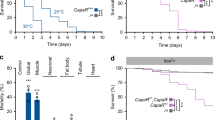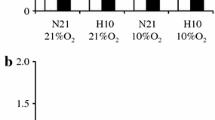Abstract
In many bird species, the nasal glands secrete excess salt ingested with drinking water or food. In ducks (Anas platyrhynchos), osmotic stress results in adaptive cell proliferation and differentiation in the gland. Using ‘naive’ nasal gland cells isolated from animals that had never ingested excess salt or ‘differentiated’ cells from animals fed with a 1% NaCl solution for 48 h, we investigated the allocation of metabolic energy to salt excretory processes and to other cellular activities. Activation of muscarinic acetylcholine receptors (carbachol) or β-adrenergic receptors (isoproterenol) in nasal gland cells resulted in a transient peak in metabolic rate followed by an elevated plateau level that was maintained throughout the activation period. Activation of cells using vasoactive intestinal peptide, however, had only marginal effects on metabolic rate. In differentiated cells, sequential stimulation with carbachol and isoproterenol resulted in additive changes in metabolic rate during the plateau phase. Naive cells, however, developed supra-additive plateau levels in metabolic rates indicating cross-talk of both signaling pathways. Using bumetanide, TEA or barium ions to block different components of the ion transport machinery necessary for salt secretion, the relative proportion of energy needed for processes related to ion transport or other cellular processes was determined. While differentiated cells in the activated state allocated virtually all metabolic energy to processes related to salt secretion, naive cells reserved a significant amount of energy for other processes, possibly sustaining cellular signaling and regulating biosynthetic mechanisms related to adaptive growth and differentiation.








Similar content being viewed by others
References
Bentz C, Schwarz M, Hildebrandt J-P (1999) Cytosolic pH affects DNA synthesis in nasal gland cells of osmotically stressed ducklings, Anas platyrhynchos. Zoology 102:10–17
Ernst SA, Ellis RA (1969) The development of surface specialization in the secretory epithelium of the avian salt gland in response to osmotic stress. J Cell Biol 40:305–321
Gerstberger R, Gray DA (1993) Fine structure, innervation and functional control of avian salt glands. Int Rev Cytol 144:130–215
Gerstberger R, Sann H, Simon E (1988) Vasoactive intestinal peptide stimulates blood flow and secretion of avian salt glands. Am J Physiol 255:R575–R582
Grynkiewicz G, Poenie M, Tsien RY (1985) A new generation of Ca2+ indicators with greatly improved fluorescence properties. J Biol Chem 260:3440–3450
Hasse P, Fourman J (1970) The autonomic innervation of the avian salt gland. J Anat 107:382–383
Hildebrandt J-P (1997) Changes in Na+/K+-ATPase expression during adaptive cell differentiation in avian nasal salt gland. J Exp Biol 200:1895–1904
Hildebrandt J-P (2001) Coping with excess salt: adaptive functions of extrarenal osmoregulatory organs in vertebrates. Zoology 104:209–220
Hildebrandt J-P, Prowald A (2000) Ca2+ and p38 MAP kinase regulate mAChR-mediated c-Fos expression in avian exocrine cells. Am J Physiol 278:C879–C884
Hildebrandt J-P, Shuttleworth TJ (1991) Inositol phosphates and [Ca2+]i signals in a differentiating exocrine cell. Am J Physiol 261:C210–C217
Hossler FE (1982) On the mechanism of plasma membrane turnover in the salt gland of ducklings. Cell Tissue Res 226:531–540
Lowy RJ, Ernst SA (1987) β-Adrenergic stimulation of ion transport in primary cultures of avian salt glands. Am J Physiol 252:C670–C676
Lowy RJ, Dawson DC, Ernst SA (1985) Primary culture of duck salt gland. II. Neurohormonal stimulation of active transport. Am J Physiol 249:C41–C47
Lowy RJ, Schreiber JH, Ernst SA (1987) Vasoactive intestinal peptide stimulates ion transport in avian salt gland. Am J Physiol 253:R801–R808
Lowy RJ, Dawson DC, Ernst SA (1989) Mechanism of ion transport by avian salt gland primary cell cultures. Am J Physiol 256:R1184–R1191
Martin SC, Shuttleworth TJ (1994a) Vasoactive intestinal peptide stimulates a cAMP-mediated Cl− current in avian salt gland cells. Regul Pept 52:205–214
Martin SC, Shuttleworth TJ (1994b) Muscarinic-receptor activation stimulates oscillations in K+ and Cl− currents which are acutely dependent on extracellular Ca2+ in avian salt gland cells. Pflügers Arch 426:231–238
Martin SC, Thompson JL, Shuttleworth TJ (1994) Potentiation of Ca2+-activated secretory activity by a cAMP-mediated mechanism in avian salt gland cells. Am J Physiol 267:C255–C265
Peaker M, Linzell JL (1975) Salt glands in birds and reptiles. Cambridge University Press, Cambridge
Richards NW, Lowy RJ, Ernst SA, Dawson DC (1989) Two K+ channel types, muscarinic agonist-activated and inwardly rectifying, in a Cl− secretory epithelium: the avian salt gland. J Gen Physiol 93:1171–1194
Schmidt-Nielsen K (1960) The salt-secreting gland of marine birds. Circulation 21:955–967
Shuttleworth TJ (1995) Intracellular signals controlling ionic and acid-base regulation in avian nasal gland cells. Adv Comp Environ Physiol 22:185–202
Shuttleworth TJ, Hildebrandt J-P (1999) Vertebrate salt glands: short- and long-term regulation of function. J Exp Zool 283:689–701
Shuttleworth TJ, Thompson JL (1989) Intracellular [Ca2+] and inositol phosphates in avian nasal gland cells. Am J Physiol 257:C1020–C1029
Snider MR, Roland RM, Lowy RJ, Agranoff BW, Ernst SA (1986) Muscarinic receptor-stimulated Ca2+ signaling and inositol lipid metabolism in avian salt gland cells. Biochim Biophys Acta 889:216–224
Author information
Authors and Affiliations
Corresponding author
Additional information
Communicated by G. Heldmaier
Rights and permissions
About this article
Cite this article
Krohn, M., Hildebrandt, JP. Cross-talk of phosphoinositide- and cyclic nucleotide-dependent signaling pathways in differentiating avian nasal gland cells. J Comp Physiol B 174, 461–470 (2004). https://doi.org/10.1007/s00360-004-0432-6
Accepted:
Published:
Issue Date:
DOI: https://doi.org/10.1007/s00360-004-0432-6




